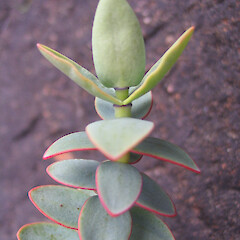Veronica amplexicaulis f. amplexicaulis
Common name
hebe
Synonyms
Hebe amplexicaulis var. erecta Cockayne et Allan, Hebe amplexicaulis var. suberecta Cockayne et Allan, Hebe amplexicaulis (J.B.Armstr.) Cockayne et Allan f. amplexicaulis
Family
Plantaginaceae
Flora category
Vascular – Native
Endemic taxon
Yes
Endemic genus
No
Endemic family
No
Structural class
Trees & Shrubs - Dicotyledons
Chromosome number
2n = 40
Current conservation status
The conservation status of all known New Zealand vascular plant taxa at the rank of species and below were reassessed in 2017 using the New Zealand Threat Classification System (NZTCS) – more information about this can be found on the NZTCS website. This report includes a statistical summary and brief notes on changes since 2012 and replaces all previous NZTCS lists for vascular plants.
Please note, threat classifications are often suggested by authors when publications fall between NZTCS assessment periods – an interim threat classification status has not been assessed by the NZTCS panel.
- Conservation status of New Zealand indigenous vascular plants, 2017 . 2018. Peter J. de Lange, Jeremy R. Rolfe, John W. Barkla, Shannel P. Courtney, Paul D. Champion, Leon R. Perrie, Sarah M. Beadel, Kerry A. Ford, Ilse Breitwieser, Ines Schönberger, Rowan Hindmarsh-Walls, Peter B. Heenan and Kate Ladley. Department of Conservation. Source: NZTCS and licensed by DOC for reuse under the Creative Commons Attribution 4.0 International licence.
2017 | At Risk – Naturally Uncommon | Qualifiers: DP, Sp
Previous conservation statuses
2012 | At Risk – Naturally Uncommon | Qualifiers: Sp
2009 | At Risk – Naturally Uncommon
2004 | Range Restricted
Brief description
Low bushy shrub with blue-green oval pairs of leaves which clasp the stem at their base and with very short (to 5cm long) spikes of white flowers inhabiting inland south Canterbury. Leaves broad, with reddish margin, 12-21mm long. Leaf bud with no gap at base.
Distribution
Endemic. New Zealand: South Island (south Canterbury (Mt Somers, Mt Peel, Four Peaks Range and Orari Gorge).
Habitat
Low montane to subalpine (mostly subalpine). A rupestral of steep-sided rock outcrops – where it grows in joints and crevices, gorges and more rarely boulder falls
Detailed description
Small to medium-sized shrubs, branching from the base. Stems trailing to erect, naked except near apex, sparingly branched, glabrous or sometimes with a few hairs near leaf bases, 150-600 mm long. Leaves oblong, spreading, glaucous, glabrous, amplexicaul or abruptly narrowed to broad base, 10-30 × 5-15 mm; apex obtuse, rarely acute; margins red or green. Inflorescence a dense simple spike, peduncle hairy, 20-25 mm. Flowers sessile. Bracts and calyx lobes about equal, 2.0-2.5 mm, ciliate or pubescent all over, broadly ovate, subacute. Corolla white, tube exceeding calyx, lobes narrow. Anthers purple. Capsule ovoid, rounded at apex, narrowly latiseptate, pubescent, very dark brown, about equalling calyx; valves thick walled.
Similar taxa
Similar to Veronica pareora from which it is distinguished by its usually shorter stems, smaller leaves, pubescent peduncles, and usually non-pedicellate flowers (some plants in the upper Rangitata area have inflorescences whose basal flowers are pedicellate). Veronica amplexicaulis f. amplexicaulis differs from f. hirta by its glabrous leaves and mostly glabrous branchlets
Flowering
October - January (-March)
Flower colours
Violet/Purple, White
Fruiting
January - December
Propagation technique
Easily grown from cuttings and fresh seed. Prefers a sunny site and should be planted in a free draining soil. Dislikes humidity
Threats
Not Threatened. A Naturally Uncommon, range restricted and sparsely distributed plant which is widespread but never particularly common within its few known habitats. Some populations may be threatened by browsing animals.
Etymology
veronica: Named after Saint Veronica, who gave Jesus her veil to wipe his brow as he carried the cross through Jerusalem, perhaps because the common name of this plant is ‘speedwell’. The name Veronica is often believed to derive from the Latin vera ‘truth’ and iconica ‘image’, but it is actually derived from the Macedonian name Berenice which means ‘bearer of victory’.
amplexicaulis: From the Latin amplexus ‘clasped’ and caulis ‘stem’ or ‘stalk’, meaning stem-clasping
Where To Buy
Not commercially available.
Attribution
Fact Sheet by Peter J. de Lange (18 August 2006): Description from Garnock-Jones and Mooloy (1982)
References and further reading
Garnock-Jones, P.J.; Molloy, B.P.J. 1982: Polymorphism and the taxonomic status of the Hebe amplexicaulis complex (Scrophulariaceae). New Zealand Journal of Botany 20: 391-399.
NZPCN Fact Sheet citation
Please cite as: de Lange, P.J. (Year at time of access): Veronica amplexicaulis f. amplexicaulis Fact Sheet (content continuously updated). New Zealand Plant Conservation Network. https://www.nzpcn.org.nz/flora/species/veronica-amplexicaulis-f-amplexicaulis/ (Date website was queried)





